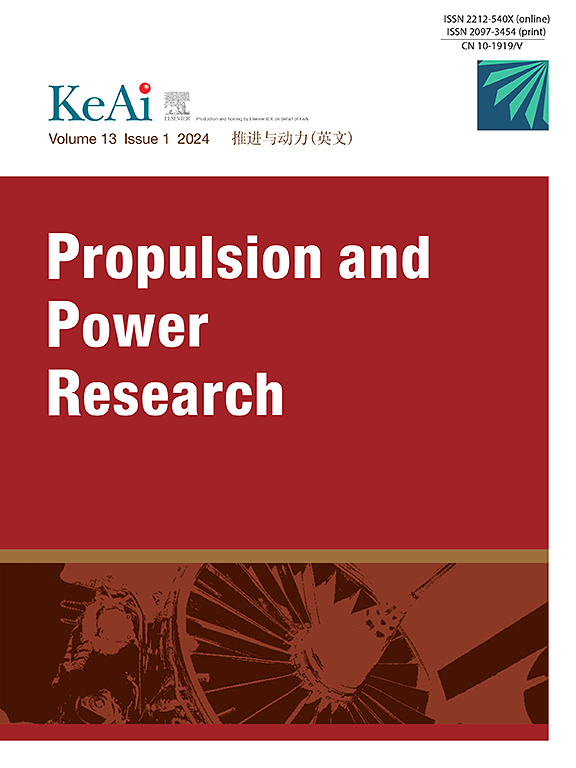Aerodynamic response of a blade cascade to torsional excitation of one blade at subsonic and transonic velocities
IF 5.4
2区 工程技术
Q1 ENGINEERING, AEROSPACE
引用次数: 0
Abstract
The trend of increasing the power-to-weight ratios of aircraft turbofan engines and efficiency of steam turbines leads to designs with long and slender blades often operating at transonic flow conditions. Such blades are prone to undesirable and possibly destructive vibrations caused by engine-order excitation or induced by flow itself. To shed more light on this problem and to extend the existing knowledge, this paper presents experimental and numerical study on torsional mode vibration of one blade in a linear blade cascade of flat profiles. In this study, dynamic loading and pressure distributions were investigated at subsonic, supercritical and transonic flow regimes while the blade was kinematically excited by a motor and shaft mechanism at reduced frequencies up to k = 0.47. Dynamic flow structure development was documented and analyzed based on numerical simulations. Furthermore, dependence of energy transfer over an oscillation cycle on frequency and exit Mach number was investigated. Results revealed significant hysteresis in the flow field configuration particularly at supercritical and transonic cases. Hysteresis is manifested namely by different development of supersonic regions when the oscillating blade passes through the zero deflection during upstroke and downstroke. Resulting aerodynamic moment is non-harmonic and there is an increasing phase lag with respect to the blade deflection when oscillation frequency increases. In majority of investigated regimes, hysteresis resulted in aerodynamic damping of the blade oscillation.
叶片叶栅在亚声速和跨声速下对单叶扭转激励的气动响应
随着航空涡扇发动机功率重量比和汽轮机效率的不断提高,人们设计出了长而细长的叶片,叶片通常工作在跨声速流动条件下。这样的叶片容易产生不希望的、可能是破坏性的振动,这是由发动机级激励或由流动本身引起的。为了进一步阐明这一问题并扩展已有的知识,本文对平坦型线叶栅中单叶的扭转模态振动进行了实验和数值研究。在这项研究中,研究了在亚音速、超临界和跨音速流态下,当叶片由电机和轴机构在k = 0.47的降低频率下进行运动激励时的动态载荷和压力分布。在数值模拟的基础上,对流动结构的动态发展进行了记录和分析。此外,还研究了振荡周期内能量传递与频率和出口马赫数的关系。结果表明,流场结构存在明显的滞后性,特别是在超临界和跨音速情况下。滞回表现为振荡叶片在上行程和下行程经过零偏转时,超声速区域的发展不同。由此产生的气动力矩是非谐波的,并且随着振荡频率的增加,相对于叶片偏转存在一个增加的相位滞后。在大多数研究状态下,迟滞导致了叶片振动的气动阻尼。
本文章由计算机程序翻译,如有差异,请以英文原文为准。
求助全文
约1分钟内获得全文
求助全文
来源期刊

Propulsion and Power Research
Multiple-
CiteScore
7.50
自引率
5.70%
发文量
30
期刊介绍:
Propulsion and Power Research is a peer reviewed scientific journal in English established in 2012. The Journals publishes high quality original research articles and general reviews in fundamental research aspects of aeronautics/astronautics propulsion and power engineering, including, but not limited to, system, fluid mechanics, heat transfer, combustion, vibration and acoustics, solid mechanics and dynamics, control and so on. The journal serves as a platform for academic exchange by experts, scholars and researchers in these fields.
 求助内容:
求助内容: 应助结果提醒方式:
应助结果提醒方式:


